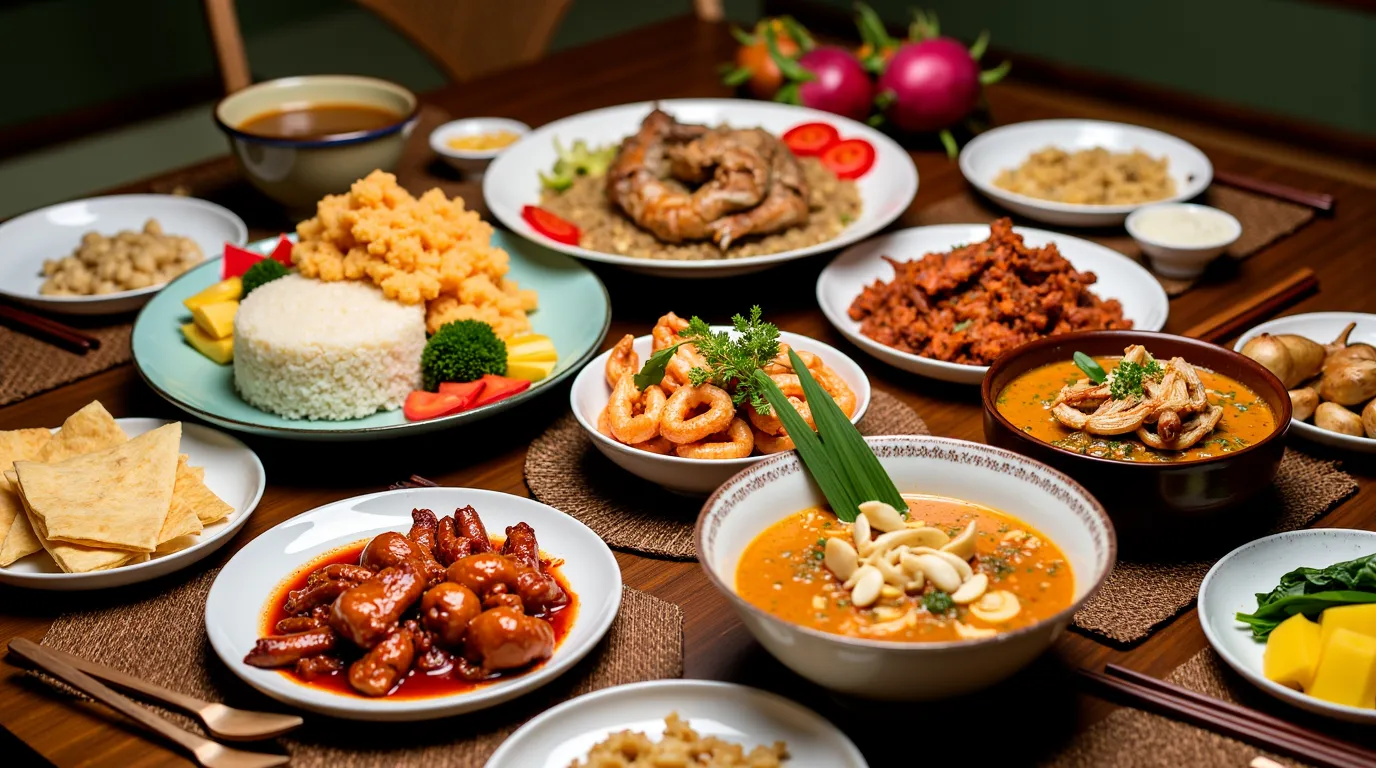Table of Contents
Table of Contents
Introduction
Singapore is often referred to as the melting pot of Asia, and nowhere is this more evident than in its food scene. Singaporean cuisine reflects the nation’s multicultural identity, blending elements from Chinese, Malay, Indian, and other regional traditions to create an extraordinary gastronomic tapestry. As you wander through the hawker centers, food courts, and upscale restaurants scattered across this city-state, you’ll discover dishes that embody centuries of culinary evolution. From tangy soups and aromatic curries to succulent seafood and sweet desserts, the range of flavors is dazzling.
In recent years, Singaporean cuisine has gained increasing global recognition, thanks to its mix of complex spices, fresh ingredients, and inventive cooking methods. Many food aficionados agree that Singapore’s unique setting—an island situated at the crossroads of major trade routes—has endowed its local fare with layers of taste rarely found elsewhere. Travelers come from across the world to experience Singapore’s famed hawker food, and many leave with a deeper appreciation for the cultural and historical richness behind each dish.
But there is much more to Singaporean cuisine than just delicious meals. Food also plays a vital role in the nation’s social fabric. Sharing a meal is a communal act that fosters a strong sense of unity, and many families pass down time-honored cooking traditions through the generations. For this reason, a full exploration of Singapore’s culinary heritage involves not only sampling the dishes but also understanding how these recipes were shaped by migration patterns, colonial history, and geographical influences.
This article will take you through the fascinating history of Singapore’s food culture, highlight the key ingredients that make Singaporean cuisine truly distinctive, and introduce you to some must-try dishes that exemplify the country’s gastronomic wealth. We will also delve into table rituals, modern dining trends, and tips to fully immerse yourself in this multifaceted cuisine. Whether you are a seasoned traveler, a home cook eager to recreate Singaporean dishes, or simply a curious foodie, this guide aims to offer a comprehensive view of a culinary landscape that continues to evolve and captivate.
Culinary Context and History
Early Foundations and Influences
To understand how Singaporean cuisine has evolved, we must first look to the island’s past. Prior to British colonization, the region was populated by native Malay communities who brought with them age-old cooking traditions centered on rice, seafood, and local herbs. Spices were crucial, with ingredients like lemongrass, galangal, and turmeric forming the backbone of many dishes. Trade routes that passed through the Malay Archipelago also introduced new spices and ingredients, gradually shaping local palates into a love for bold, aromatic flavors.
Colonization and Migration
When the British established a trading post on the island in the early 19th century, Singapore became a magnet for merchants, laborers, and adventurers from China, India, the Middle East, and beyond. Each group of settlers introduced their own gastronomic elements. Chinese immigrants, for instance, brought cooking styles from various regions—Cantonese, Hokkien, Teochew, Hakka—resulting in a complex layering of flavors and techniques. Similarly, Indian immigrants contributed their mastery of curries, flatbreads, and spices, leading to the fusion of tastes that underscores today’s Singaporean cuisine.
During the colonial era, Western influences also seeped into local kitchens. The British introduced breads, pastries, and cooking methods such as roasting, which merged seamlessly with the established Malay and Chinese culinary repertoire. While colonization played a significant role in shaping commerce and infrastructure, it also catalyzed the evolution of food culture by encouraging the free exchange of recipes and ingredients. Over time, dishes began to reflect a multicultural identity, forming the basis for what we now celebrate as Singaporean cuisine.
Post-Independence Development
With Singapore’s independence in 1965, national identity became a top priority, and local food turned into an emblem of Singaporean pride. Hawker centers—public food complexes that house an array of affordable food stalls—were organized by the government to ensure hygienic dining and to support small-scale food entrepreneurs. These centers quickly became gathering spots for Singaporeans from all walks of life. Today, hawker culture is nearly synonymous with Singaporean cuisine, featuring iconic dishes like Hainanese Chicken Rice, Laksa, and Chili Crab. The hawker scene also played a significant role in showcasing the distinct differences in food traditions that emerged from various parts of the city.
Regional Variations and Identity
Though Singapore is a compact island, subtle regional differences still exist due to diverse cultural enclaves. The eastern side of the island, for example, is renowned for its Peranakan heritage—a blend of Chinese and Malay influences—leading to dishes rich in coconut milk and intricate spice blends, such as Nonya Laksa or Kueh. The northern and western areas, historically more industrial and residential, developed robust hawker cultures offering hearty fare from various Chinese dialect groups. The southern region, centered around the downtown area, is where high-end restaurants and fusion dining thrive. These pockets of cultural expression coalesce, feeding into the broader tapestry that is Singaporean cuisine.
From humble beginnings shaped by Malay traditions and further developed through centuries of colonization and migration, Singaporean cuisine has blossomed into a globally recognized culinary scene. Each historical layer adds its own distinctive touch, resulting in an eclectic mix of tastes that continues to delight locals and visitors alike.
Key Ingredients and Local Products
Spices and Herbs
The backbone of Singaporean cuisine lies in its extensive use of spices. Cumin, coriander, turmeric, and chili are staples that lend depth and vibrancy to curries, sauces, and marinades. Aromatic herbs like lemongrass and pandan leaves further enhance the flavor profiles, injecting citrusy or sweet notes into dishes. Rempah, a spice paste made from pounding or blending aromatics and spices, is a cornerstone in many local recipes.
Rice, Noodles, and Grains
No discussion of Singaporean cuisine is complete without mentioning the importance of rice. Fragrant jasmine rice is typically served with mains, while glutinous rice is used for confections and cakes. Noodles also hold a special place: yellow wheat noodles, thick rice noodles (kway teow), thin vermicelli (bee hoon), and egg noodles are deployed in countless dishes, from stir-fries to soups. In particular, Hokkien Mee and Char Kway Teow are iconic noodle dishes that heavily feature seafood and savory sauces.
Proteins: Meats and Seafood
Given Singapore’s island geography, seafood is abundant. Fish, prawns, crab, and squid appear in numerous recipes, from barbecue stingray to Chili Crab. The diversity of cultural influences means that beef, pork, and chicken are also widely consumed, often marinated with soy sauce, sesame oil, and various spices. Mutton is particularly common in Indian-Muslim fare, such as mutton biryani or soups like sup kambing.
Fruits and Vegetables
Tropical fruits like durian, mango, papaya, and rambutan grow well in Singapore’s climate, adding fresh sweetness to the cuisine. Durian, known as the “King of Fruits,” is especially beloved by many locals, though its pungent aroma can be polarizing to first-timers. On the vegetable front, kangkong (water spinach), bok choy, and eggplant frequently appear in stir-fries and soups. Sambal kangkong—a dish made with a fiery chili paste—is a popular side that exemplifies the spicy dimension of Singaporean cuisine.
Seasonality and Availability
Although Singapore imports a large percentage of its produce due to limited agricultural land, certain items are more commonly available at specific times of the year. Festivals like Chinese New Year see an influx of mandarin oranges, while the durian season (typically mid-year) is highly anticipated by durian lovers. Nonetheless, modern trade networks ensure that most ingredients are available year-round, providing home cooks and chefs with ample choice.
Purchasing Tips
For those eager to recreate Singaporean cuisine at home, sourcing quality ingredients can make all the difference. In Singapore, popular local markets such as Tekka Market and Chinatown Complex Market offer fresh produce, meats, seafood, and spices. Travelers will enjoy the experience of walking through rows of colorful vegetables, glistening fish, and aromatic spice piles. Outside Singapore, specialty Asian grocery stores often stock essentials like rice noodles, chili paste, and fresh Asian herbs. Online retailers also cater to global demand for authentic spices and sauces, delivering these items to doorsteps around the world.
Must-Try Traditional Dishes
One of the joys of exploring Singaporean cuisine is discovering the wealth of dishes that range from humble street food to elaborate festival feasts. Here are some of the most iconic offerings that perfectly capture the spirit of this culinary melting pot.
Hainanese Chicken Rice
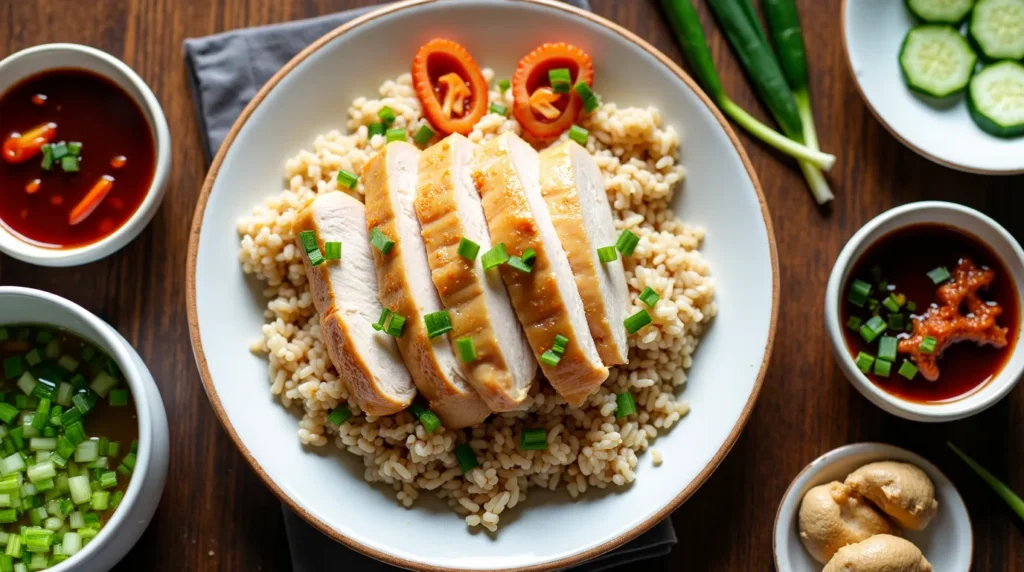
Dubbed the “national dish” by many, Hainanese Chicken Rice is a deceptively simple yet astonishingly flavorful meal. Adapted from the Hainanese who arrived from southern China, the dish traditionally features poached chicken served with fragrant rice cooked in chicken stock, garlic, and ginger. Accompanying sauces—chili, ginger paste, and dark soy—allow diners to customize each bite. While variations exist, the essence remains the same: tender chicken and aromatic rice. If you want to try making it at home, a simplified recipe involves poaching the chicken with garlic and ginger, saving the broth to cook the rice. The key is to allow the flavors to infuse slowly, resulting in succulent meat and perfectly seasoned rice.
Laksa
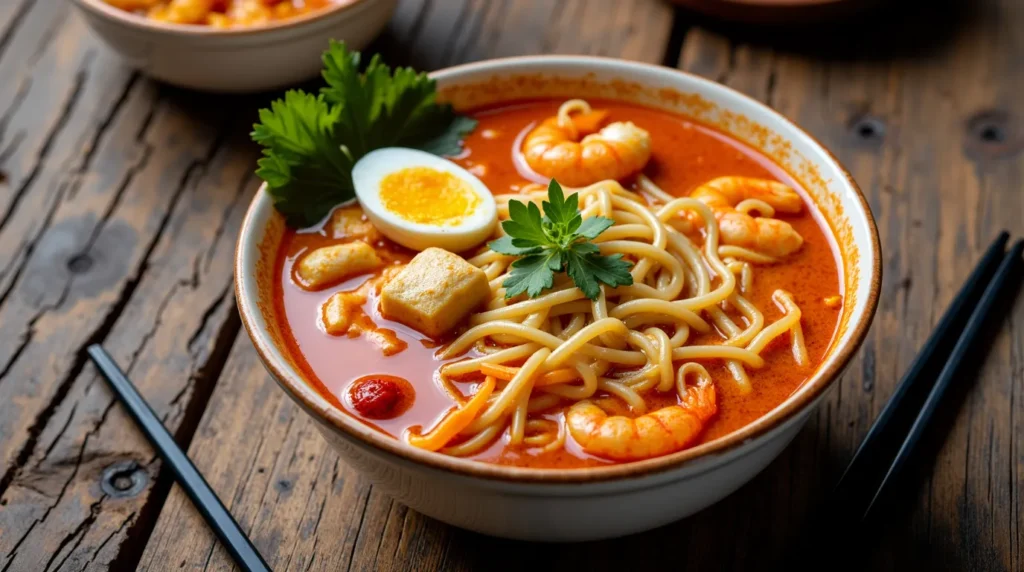
A hallmark of Peranakan heritage, Laksa is a noodle soup that merges Chinese and Malay culinary traditions. Two primary versions stand out: Curry Laksa, featuring a coconut milk-based broth, and Asam Laksa, which relies on sour tamarind for its tangy flavor. The more common Singaporean style, often simply called Laksa, has a rich, mildly spicy broth brimming with noodles, prawns, and fish cakes. What makes Laksa distinct in Singaporean cuisine is the use of thick rice noodles and a garnish of Vietnamese coriander (known locally as laksa leaf). This dish’s versatility shines in the array of regional variations—even within Singapore, some places add cockles for extra brininess, while others rely on a lighter broth.
Roti Prata
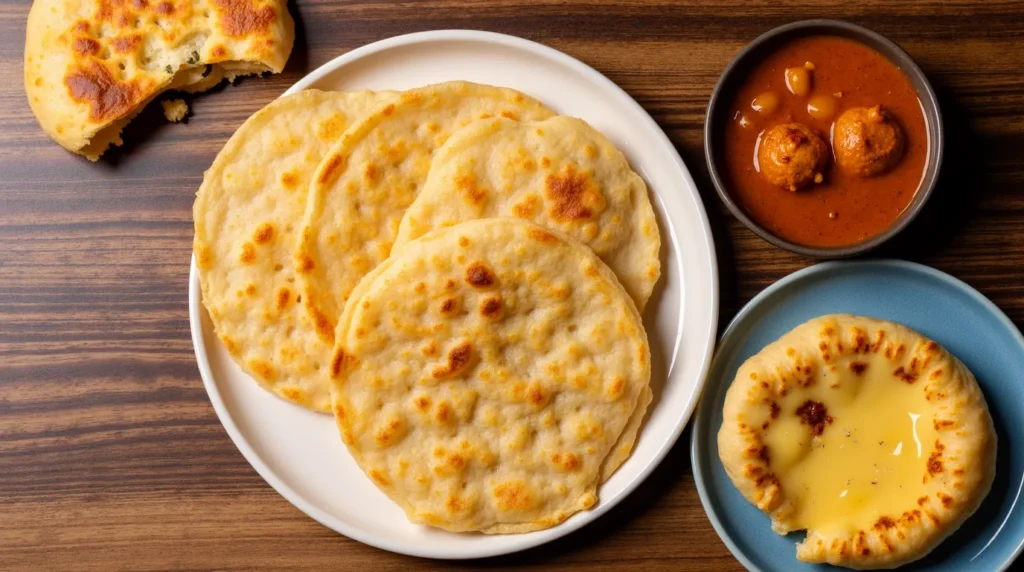
Originally of Indian origin, Roti Prata has become a beloved breakfast and supper staple across the island. The dough—made from flour, ghee, and water—is stretched thin, folded, and then fried until crispy on the outside and fluffy on the inside. Traditional versions come plain or with egg, but modern variations include fillings like cheese, onion, mushrooms, or even ice cream for dessert prata. The typical accompaniment is a bowl of curry or a side of sugar, and the best roti prata stalls skillfully balance tenderness with a golden, flaky exterior.
Bak Kut Teh
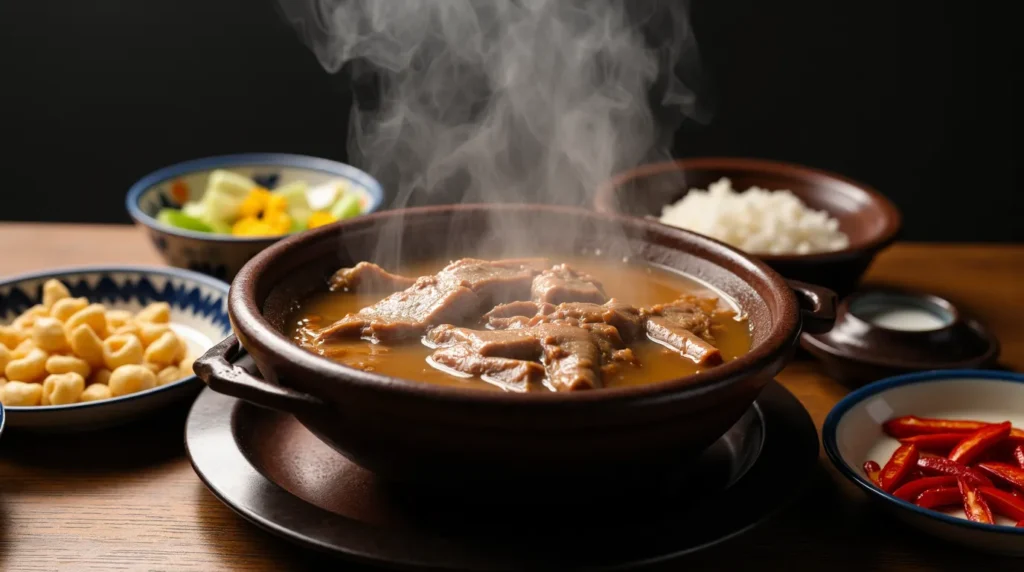
Literally translating to “meat bone tea,” Bak Kut Teh is a pork rib soup simmered in a broth infused with garlic, pepper, and various herbs. Despite its name, tea is not usually an ingredient in the soup; rather, hot tea is often served alongside to help cut through the fattiness of the dish. There are two main styles: the Teochew version, which is lighter and peppery, and the Klang version, which is darker and features more complex herbal notes. Both represent an essential part of Singaporean cuisine, often enjoyed as a hearty breakfast or late-night supper.
Regional Variations
Some dishes that originate from a single ethnic tradition can take on new flavors as they migrate across neighborhoods. For instance, the Malay dish Mee Rebus, a noodle dish in a thick gravy made from sweet potatoes and spices, can taste slightly different in the east versus the west of Singapore due to tweaks in spices or the degree of sweetness. These small but meaningful differences make exploring Singaporean cuisine a delight for adventurous palates.
Defining Characteristics of Singaporean Cuisine
At first glance, the variety in Singaporean cuisine may seem overwhelming. Yet a few unifying characteristics stand out, illustrating why the local fare captivates food lovers from around the globe.
- Bold Use of Spices
The influence of Malay, Indian, and Chinese cooking ensures that spices remain central. While dishes can be fiery, they are often balanced by aromatic ingredients like lemongrass, pandan, or coconut milk. - Sweet and Savory Contrasts
Many staples, such as Chili Crab or Curry Laksa, skilfully balance sweetness with saltiness and heat. This contrast keeps the palate engaged and highlights different facets of each ingredient. - Diverse Cooking Techniques
Stir-frying, steaming, grilling, and slow-cooking all coexist in Singaporean cuisine. The technique used often depends on the dish’s cultural origins and the flavors that need to be accentuated. - Layered Flavors and Textures
A signature characteristic of Singaporean cuisine is layering. A single dish might feature crunchy fried shallots, smooth coconut gravy, chewy noodles, and spicy sambal, all melding together in one bowl.
For food enthusiasts seeking new adventures, Singaporean cuisine offers a bevy of reasons to explore. Its flavorful spices, intriguing textural contrasts, and cultural richness provide a unique dining experience. Whether you love sweet, savory, or spicy fare, there’s likely a Singaporean dish that will capture your heart.
Tips and Highlights to Encourage People to Try This Cuisine
- Cultural Immersion
One of the best ways to understand a culture is through its food. Sampling Singaporean cuisine provides insight into the city-state’s history and multicultural roots. - Great for Sharing
Many Singaporean dishes are served in large portions, ideal for communal meals. Bring your friends and family along to share plates of Hainanese Chicken Rice, Chili Crab, or various noodle dishes. - Affordability
Although Singapore can be expensive in other aspects, delicious local fare is often surprisingly budget-friendly, especially at hawker centers. You can enjoy a hearty meal without breaking the bank. - Adventurous Eating
If you love discovering new tastes, Singaporean cuisine will not disappoint. From the pungent durian fruit to rich bone broths and fiery sauces, the local palate is adventurous in every sense. - A Foodie’s Paradise
Food festivals, night markets, and culinary events happen year-round. These gatherings celebrate tradition while pushing creative boundaries, making every visit a fresh experience.
By delving into these local favorites and sampling a broad range of dishes, you not only expand your culinary horizons but also participate in a heritage that has been centuries in the making. Anecdotes from travelers often involve the discovery of a beloved dish at a modest hawker stall, proving that hidden gems are waiting around every corner.
Table Rituals and Customs
Typical Meal Structure
In Singapore, meals are more than just sustenance; they’re social events that bring people together. Breakfast might include kaya toast (toast spread with coconut jam) and soft-boiled eggs, accompanied by strong local coffee known as kopi. Lunch and dinner are usually heartier, featuring rice, noodles, and a variety of side dishes like stir-fried vegetables, curries, and braised meats.
Snacking is common as well, especially in a city teeming with food stalls that operate late into the night. Afternoon and late-night bites can range from sweet snacks, such as chendol (shaved ice dessert with coconut milk and palm sugar), to savory treats like curry puffs.
Table Etiquette
With a multicultural population, table manners and dining customs can vary. In Chinese households, it’s customary to share dishes placed in the center of the table, while in Indian-Muslim settings, eating with the right hand is a common practice. Being mindful of Halal dietary requirements is vital, especially when dining with Muslim friends. For example, if you plan a communal meal, opt for a Halal-certified restaurant or dishes made without pork or non-Halal meats.
Offering food to elders or guests before serving yourself is considered polite, reflecting the collective nature of Singaporean society. When chopsticks are used, it’s considered poor form to stick them vertically in a bowl of rice, as this can signify funeral rituals in certain Chinese traditions.
Special Occasions and Festivals
National holidays, cultural celebrations, and religious events play a significant role in shaping Singaporean cuisine. During Chinese New Year, families gather to toss yusheng, a raw fish salad that symbolizes prosperity. Ramadan brings forth an abundance of bazaars offering savory Malay dishes and sweet treats to break the fast. Deepavali is a time for Indian sweets and snacks, while Christmas sees an infusion of Western-style feasts. Each festival often comes with its own set of traditional delicacies, highlighting the city’s inclusive and diverse nature.
Weddings and family gatherings are also lavish affairs, featuring multi-course meals that combine influences from various ethnic backgrounds. A typical Chinese wedding banquet, for instance, might include cold platters, seafood delicacies, and dessert soups. Meanwhile, a Malay wedding feast will showcase rendang, satay, and festive rice dishes. These celebrations exemplify how Singaporean cuisine adapts to different cultural contexts while retaining its core flavors and communal spirit.
Modern Trends and Culinary Fusions
Global Influences and Fusion Cuisine
Over the past few decades, Singaporean cuisine has not only preserved its traditional roots but also embraced new influences. Singapore’s role as an international hub attracts chefs from across the globe. Many have chosen to experiment with local ingredients, leading to innovative fusion cuisines that marry Eastern and Western elements in thrilling ways. You might encounter chili-infused pasta dishes, laksa-flavored risottos, or even durian-flavored pastries. Far from losing its identity, modern Singaporean food culture thrives on pushing boundaries while honoring time-honored techniques.
Healthy and Sustainable Eating
A growing emphasis on health and sustainability has sparked new culinary trends. More restaurants and home cooks are focusing on fresh, locally sourced produce. Organic farms in neighboring countries contribute to a slow but noticeable shift toward farm-to-table dining. Vegetarian and vegan options are also expanding in popularity, spurred by environmental awareness and changing lifestyle choices. In some hawker stalls, traditional recipes have been modified to use less oil, less sugar, and more nutrient-dense ingredients, ensuring that beloved dishes remain both delicious and mindful of health considerations.
Young Chefs and Restaurateurs
A new generation of chefs is emerging, determined to showcase Singaporean cuisine in innovative ways. They might reinterpret classics using contemporary plating or substitute traditional proteins with plant-based alternatives. Some experiment with molecular gastronomy techniques, creating deconstructed versions of Laksa or Hainanese Chicken Rice that surprise the palate. These culinary trailblazers often highlight their Malay, Chinese, Indian, or Eurasian heritage in signature dishes, adding personal flair and narrative to the vibrant tapestry of Singapore’s food scene.
Establishments like “mod-Sin” (modern Singaporean) restaurants are increasingly gaining traction. They serve creative spins on hawker favorites in hip settings, offering tasting menus that bridge nostalgia and novelty. While some purists may initially balk at these reimagined dishes, the ongoing dialogue between tradition and innovation underscores the dynamism of Singaporean cuisine. Rather than replacing heritage with novelty, these chefs seek to expand the possibilities, ensuring that local gastronomy remains relevant in the 21st century.
Conclusion and Call to Action
From its humble beginnings to its status as a global culinary hotspot, Singaporean cuisine stands as a testament to the island’s vibrant history and multicultural ethos. Over centuries, waves of migration, colonization, and cultural exchange have forged a gastronomic identity that’s at once familiar and adventurous. Whether through the aromatic spices in a bubbling pot of Laksa, the sweet-and-spicy punch of Chili Crab, or the comforting simplicity of Hainanese Chicken Rice, each dish tells a unique story of resilience, innovation, and unity.
We have explored the key pillars of this culinary landscape—its rich history, iconic ingredients, must-try dishes, defining characteristics, and evolving modern trends. We’ve also seen how table rituals and cultural celebrations underscore the significance of sharing food in bringing communities together. As Singaporean cuisine continues to evolve, it remains firmly grounded in the traditions and flavors that have made it beloved by locals and admired by visitors worldwide.
Now, it’s your turn to dive into this world of culinary wonders. Try your hand at cooking a simple Singaporean dish at home—perhaps a pot of Chicken Rice or a comforting bowl of Laksa. If you’re traveling to Singapore, make sure to visit a hawker center for an authentic taste of everyday life, and don’t forget to share your findings with friends and family. Food is always more meaningful when savored in good company.
Feel free to share your own experiences or favorite Singaporean recipes in the comments. Have you tried your hand at replicating Chili Crab at home? Did you discover a hidden hawker gem that you wish more people knew about? Your stories can inspire others to embark on their own gastronomic adventures.
For our next article, we might delve deeper into the realm of Peranakan desserts—another facet of Singaporean cuisine that balances sweet, savory, and spicy elements in unexpected ways. Until then, may every bite you take bring you closer to understanding the rich tapestry of flavors and cultures that make Singapore’s food scene so endlessly captivating.

